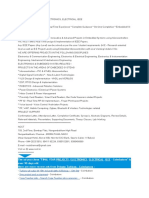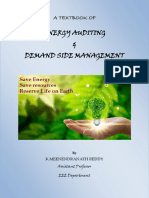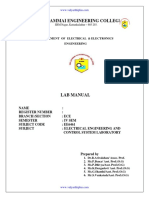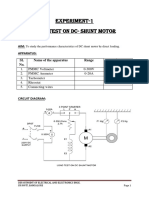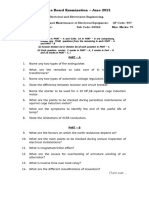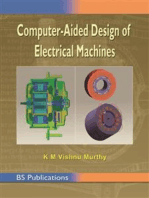UNIT 3 Notes
Uploaded by
Trupti NandikolmathUNIT 3 Notes
Uploaded by
Trupti NandikolmathCourse code: 17MCC03
UNIT VI
Energy management & Audit
Contents
1. objective of energy management
2. Need and scope of energy audit
3. Methodology
4. Types of energy audit
5. Material and energy balance
6. Energy auditing instruments
7. Maintenance and audit
Dept. ECE,SET ,JU. Page 1
Course code: 17MCC03
1. Objective of energy management:
To minimize the energy costs/waste without affecting production and quality
To minimize environmental effects
To optimize utilization and procurement of energy
2. Need and scope of energy audit:
2.1 Need energy audit:
To understand which type of fuel/energy is being used in particular
process/products.
In identifying the quantity and cost of various energy forms.
In identifying the energy consumption at various levels.
In highlighting wastage by relating energy input and production output.
2.2 Scope of energy audit:
Monitoring energy consumption
Considering possibility of savings
Recommending appropriate policies for bringing down energy consumption
Possibility of avoiding losses
Detailed analysis of present consumption and past trends
Reviewing lighting requirements
Check capacities and efficiencies of equipments
Check working of controls like fire alarms etc
Compare standard consumption to actual
Need for publicity campaigns
Examine need of automatic controls
Dept. ECE,SET ,JU. Page 2
Course code: 17MCC03
3. Methodology:
The methodology employed in energy audit is:
Conducting a survey if energy use and conservation study to identify scope and
possible areas of conservation
Work out techno economic feasibility in the use of alternative sources of energy
Step1: Interview with key facility personnel
Step2: Facility tour
Step3: Document review
Step4: Facility inspection
Step5: Staff interview
Step6: Utility analysis
Step7: Identify/Evaluate feasible ECMs
Step8: Economic analysis
Step9: Prepare report summarizing audit finding
4. Types of energy audit:
The factors on which energy audit depends on are as follows:
Type of industry.
Type of fuel/ energy being used.
Depth to which final audit is needed.
Different functionalities and process performed in industry.
Investment and time availability.
Potential and magnitude of cost reduction required.
The energy auditing process can be classified to different forms depending on the depth and
intensity of audit required, based on the demands of different sectors in which auditing is done.
In general auditing process is done to check some parameters like amount of energy
consumption, energy utilization, wastage, qualitative and quantitative measure of products
produced, and its contribution to economic development. Few different types are mentioned
below:
Dept. ECE,SET ,JU. Page 3
Course code: 17MCC03
1) Walk through audit: This type of audit includes visual inspections of energy utilization,
conservation, wastage and other energy associated parameters, it requires less cost and
time to complete.
2) Mini audit: This type of audit is done based on the tests and measurements to quantify
the energy associated parameters such as utilization, conservation, wastage etc.
3) Maxi audit: This type of audit is a systematic and detailed audit which includes scientific
approaches, computer simulations, scientific models to determine the energy usage
patterns and distributions, it includes detailed analysis of energy related parameters at
each stage and hence time consuming and costly.
4.1 Energy audit based on different functions involved:
This type of energy audit determines the qualitative and quantitative requirements of the
energy at different functions carried out in the different sectors.
1) Heating, ventilation and air- conditioning
2) Lighting
3) Air distribution
4) Steam generation
5) Steam distribution
4.2 Energy based on the different process involved:
1) Heat treatment
2) Cooling
This type of audit determines the amount of energy required for a specific process and
scope of energy savings.
4.3 According to utilities
1) Boiler house
2) Store office
Dept. ECE,SET ,JU. Page 4
Course code: 17MCC03
3) Works dispensary
4) Maintenance workshop
5) Tool room
6) Power house
Utility audit determines the amount of energy utilized by a specific utility and scope of energy
savings.
4.4 According to coverage
1) Macro energy audit: This type of audit takes two to three days and provides overview of
different processed, functions and identifies substantial scope of energy savings.
2) Micro energy audit: This type of audit last for six to seven day and provides deep view
of different processes, function and identifies key area that require attention and specific
recommendation for improvement.
4.5 According to information collection method:
1) Billing audit: It is done by collecting information based on the bills. These bills provide
detail information about payment made for energy production and utilization. In this type
of audit data is collected by only bills.
2) Field audit: This type of audit is done by collecting information through actual visit to
site than calculations are done for various aspects of energy production, utilization,
losses, field audit provides specific recommendation for improvement.
4.6 Preliminary audit
This is the first stage of audit before detailed audit.
4.6.1 Objective of preliminary audit:
Highlight the deficiencies in objectives, procedures and planning.
Find out the scope of saving.
To understand the energy consumption in different departments/ process of an
organizations.
Identify the areas of critical improvements and saving is required.
Dept. ECE,SET ,JU. Page 5
Course code: 17MCC03
Collect all the data that is easily available.
Set and establish the input and output standards.
4.7 Detailed energy audit:
This involves the total examinations of organization and analysis of efficiency and
effectiveness of the present system. It includes the detailed analysis of detailed accountability at
various intermediate stages.
Objectives:
To ensure the optimum utilization on all the resources including money, materials,
machines, men and methods.
To highlight deficiencies in procedures and planning.
To suggest improvement in methods of operations.
To highlight weak links in internals control system and suggesting improvements.
To provide accurate estimations of energy savings and cost.
The detailed audit phases are as follows:
1) Phase –I ---- Pre-audit.
2) Phase- II---- Audit phase.
3) Phase-III---- Post audit.
4.7.1 Phase—I Pre- audit activities:
This includes the initial site study, which is very useful for planning of future activities.
During the initial site visits the energy audit/ engineers should carry out the following actions:
1) Discuss with the set’s senor management the aims of energy audit.
2) Discuss about economic guidelines/ financial strength.
3) Issue a questionnaire which is related to types of instruments and equipments in use,
existing operations, procedures and control methods.
4) Collect details of all related data aboyt major energy consumption
Dept. ECE,SET ,JU. Page 6
Course code: 17MCC03
5) Obtained detailed site drawings.
The main objectives of the site visit are:
1) To finalize energy audit team.
2) To finalize the list of the instruments needed for energy audit.
3) To identify the main fi=ous area for energy saving during the audit.
4) To decide any instruments and meters need to be installed prior to the audit (eg: kWh
steam,, oil or gas meters)
5) To prepare complete systematic schedule of audit.
4.7.2 Phase-II detailed energy audit activities:
The total time taken for this stage depends on the type of the industry/ site. A detailed study
need to be established at each and every unit of the system. the following are the steps carried
out in detailed audit:
1) Study the primary data, process flow diagram, energy utility diagrams.
2) Record important data, conduct survey and monitor the process.
3) Conduct detailed experiments for selected machines/ process.
4) Collect the information of the material and energy balances, energy wastage at different
stages.
5) Identification and development of energy conservation opportunities by using some
important effective techniques.
6) Finalize the best energy conservation opportunities by applying cost benefits analysis
techniques.
7) Prepare a detailed energy audit report with standard formats.
4.7.3 Phase –III Post audit phase:
Assist and implement ENCON recommendation measures and monitor the performances
.periodical review the performances of the system and follow-up.
Dept. ECE,SET ,JU. Page 7
Course code: 17MCC03
5. Material and Energy Balance:
Material and energy balances are very important in an industry which is
fundamental for controlling the process such that any changes in the process , the
material balance has to be determined again.
5.1 Material Balance:
Material balance are based on Fundamental law of conservation of mass
Types of process:
(A)Based on how the process varies with time:
(i) Steady state process: No changes with time
(ii) Unsteady state process: Changes with time
(B)Based on how the process Operate:
(i) Continuous process: At every instant, the process is on and product is produced.
Example: A power grid, an oil refinery
(ii) Batch process: process is fed in steps and finished products are produced during
one or more steps
Example: Making batch of products.
(iii) Semi Batch process (semi continuous): it is the mix of both continuous and batch
process. some chemicals are processed continuously and some are in batch
Types of Balance:
(A) Differential Balance: is a balance taken at a specific instant in time. it is useful in
Steady state continuous process which produces same results at any time.
(B) Integral Balance: is a balance taken at two specific instants in time and applied to
the beginning and the end of a batch process
Mass Balance Equation
The law of conservation of mass states that mass cannot be created or
destroyed.
Dept. ECE,SET ,JU. Page 8
Course code: 17MCC03
The generalized equation for any process is given as follow
∑Masses entering via. Feed streams=∑ Masses exiting via product stream
The above equation can be written for batch and continuous process as
∑ Mass in= ∑ Mass out [For a batch process]
∑ Mass in by flow= ∑ Mass out by flow [ for a continuous process]
If the process involves chemical reactions, then the equation will be as
follows:
= ∑ Mass in + Mass formed by reaction
= ∑ Mass out+ Mass used by reaction
(or)
In + formed = Out + consumed
5.2 Energy Balance:
Energy exist in many forms such as heat, mechanical work (including potential and
kinetic energy), Light (radiation), sound, electric and chemical energy but because of
inter-conversion, it is not always easy to isolate separate constituents of energy balances.
In many chemical reaction /processes, mechanical energy is insignificant and in some
mechanical energy situations ,as in the flow of fluids in pipes the frictional losses appear
as heat but the details of the heating need not to be considered
Therefore, in practical situation of energy balances consider and focus only on
dominant aspects.
The energy balance equation is driven by common laws of physics and thermo dynamics”
Energy cannot be created or destroyed”
Dept. ECE,SET ,JU. Page 9
Course code: 17MCC03
5.3 Sankey Diagram
Sankey diagram are a specific type of flow diagram in which the width of arrows is
shown proportionally to the flow quantity.
They are typically used to visualize energy or material transfers between processes.
Figure: Energy balances for a reheating furnance
Figure: Energy Flow chart
Dept. ECE,SET ,JU. Page 10
Course code: 17MCC03
6. Energy Auditing Instrument
Used for optimizing the combustion efficiency by measuring/monitoring the oxygen and
CO levels in flue gas of boilers, furnaces etc. and calculation of CO2 percentage in
excess air level and efficiency. Used for measuring temperatures from a distance using
infrared technology.
Main Equipments are as follows:
1. Power Analyzer:
These are the electrical measuring instruments use to measure electrical
parameters such as kVA, kW, PF, Hertz, Amps and Volts.
In addition some of these instruments also measure the harmonics and it is also an
portable instruments.
These instruments are applied on-line i.e. on running motors without any need to
atop the motor.
Instant measurements can be taken with hand-held meters, while more advanced
ones facilitates cumulative readings with print outs at specified intervals
2. Combustion Analyzer:
This instrument has in-built chemical cells which measures percentage of various
gases such as CO2, NOx, SOx etc.
These instruments are portable and estimates combustion efficiency of furnace,
Boilers or other fossil fuel burning devices.
Dept. ECE,SET ,JU. Page 11
Course code: 17MCC03
Two types: Digital Combustion Analyzer and Manual Combustion Analyzer.
Digital Combustion Analyzer: performs the measurements and reads out
combustion efficiency in terms of percent ,it is expensive and fairly complex.
Manual Combustion Analyzer: Requires various measurements including
temperature, oxygen content and CO2 contents of exhaust stack, after measuring
all these parameters combustion efficiency will be calculated.
3. Fuel Efficiency Monitor:
This measures oxygen and temperature of the flue gas.
Calorific values of common fuels or standard fuels are the fed into the
microprocessor which calculates the combustion efficiency.
Dept. ECE,SET ,JU. Page 12
Course code: 17MCC03
4. Fuel Gas Analyzer:
Measures Temperature, percentage of various gases such as CO2, NOx, SOx
excess air and combustion efficiency.
5. Contact Thermometer:
These are thermocouples which measures temperature of hot air, hot water by
insertion of probe into the stream.
For surface temperature a leaf type probe is used with the same instruments.
Dept. ECE,SET ,JU. Page 13
Course code: 17MCC03
6. Infrared Thermometer:
This is ma non-contact type, measures when directed at a heat source directly
gives the temperature read out.
Can be useful for measuring hot spots in furnaces, surface temperature etc.
Dept. ECE,SET ,JU. Page 14
Course code: 17MCC03
7. Pitot Tube and manometer:
Air velocity in ducts can be measured using pitot tube and inclined manometer for
further calculation of flows.
8. Water flow Meter:
This is a non contact flow measuring device using Doppler effect principle.
There is a transmitter and reciever which is positioned on opposite sides of the pipe.
The meter directly gives the flow.
Water and other fluid liquids can be easily measured with this meter.
Dept. ECE,SET ,JU. Page 15
Course code: 17MCC03
9. Speed Measurements:
a. Contact type: Tachometer is a contact type instruments ,which is useful where direct
access is possible
Dept. ECE,SET ,JU. Page 16
Course code: 17MCC03
b. Non –Contact type: Stroboscopes is a non – contact type, which is useful where
direct access is not possible.
10. Leak Detectors:
These are ultrasonic instruments used to detect leaks of gases and compressed air.
Ultrasonic leak detectors are electronic ultrasonic receivers that use precisely
turned to the frequency of hissing sound of an air leak.
They are sensitive to the noise of the smallest of air leaks.
These detectors can screen out the background noise and pick up the sound of an
air leak in the compressed air system.
With the additional probes this can be used to detect steam leaks also.
More expensive models of this detector can be interfaced with a portable
computer, can analyze the sound signal and display the status of steam system.
Dept. ECE,SET ,JU. Page 17
Course code: 17MCC03
11. Lux meters:
Illumination levels are measured with a Lux meter.
It consists of a photo cell which senses the light output, and then it converts into
electrical impulses which are calibrated as Lux.
Dept. ECE,SET ,JU. Page 18
Course code: 17MCC03
12. Thermo Hydro Clock:
This measures temperature and relative humidity
13. Sound Level Meter:
This is very useful for measuring noise level.
Dept. ECE,SET ,JU. Page 19
Course code: 17MCC03
14. Anemometer:
This measures the air velocity from heating, air conditioning or ventilating ducts or from
other sources of airflow.
15. Psychrometer:
Useful for measuring wet bulb temperature (WTB) and dry bulb temperature (DBT).
WBT and DBT reflect relative humidity.
Relative humidity is very important in HVAC and drying operations.
Dept. ECE,SET ,JU. Page 20
You might also like
- 15-Module - 1 DC Circuits - Material, Question of Moudle 1 &2!19!09-2022No ratings yet15-Module - 1 DC Circuits - Material, Question of Moudle 1 &2!19!09-20225 pages
- Unit I Basic Principles of Energy Audit: Prepared by Mr.B.Rajesh Assistant Professor, Department of EEE, Vjit100% (1)Unit I Basic Principles of Energy Audit: Prepared by Mr.B.Rajesh Assistant Professor, Department of EEE, Vjit43 pages
- Performance Evaluation of A Selected Pump and FanNo ratings yetPerformance Evaluation of A Selected Pump and Fan2 pages
- Assignment 1 - Past Year Questions April 2011No ratings yetAssignment 1 - Past Year Questions April 20113 pages
- Electrical Engineering and Simulation Lab ManualNo ratings yetElectrical Engineering and Simulation Lab Manual123 pages
- Unit - 4 - Power Electronics and Energy Storage in Smart GridNo ratings yetUnit - 4 - Power Electronics and Energy Storage in Smart Grid50 pages
- Unit-Iii Electric Heating: Part-A 1. What Are The Advantages of Electric Heating?No ratings yetUnit-Iii Electric Heating: Part-A 1. What Are The Advantages of Electric Heating?13 pages
- Updated Report of Social Connect and Responsibility - BSCK306 (1)100% (1)Updated Report of Social Connect and Responsibility - BSCK306 (1)64 pages
- Mod1-EE474 Energy Management and Auditing-KTUStudents - inNo ratings yetMod1-EE474 Energy Management and Auditing-KTUStudents - in51 pages
- Mtech Ee 1 Sem Power System Planning and Reliability v23 2012100% (1)Mtech Ee 1 Sem Power System Planning and Reliability v23 20123 pages
- Elementary Idea of The Special Features Required andNo ratings yetElementary Idea of The Special Features Required and13 pages
- VTU Question Paper of 18EE72 Power System Protection Jan-Feb-20230% (1)VTU Question Paper of 18EE72 Power System Protection Jan-Feb-20232 pages
- Series 1 EE3402 LINEAR INTEGRATED CIRCUITSNo ratings yetSeries 1 EE3402 LINEAR INTEGRATED CIRCUITS1 page
- BE3254 ELECTRICAL AND INSTRUMENTATION ENGINEERING Unit 5No ratings yetBE3254 ELECTRICAL AND INSTRUMENTATION ENGINEERING Unit 512 pages
- Performance Parameters of Phase Controlled RectifiersNo ratings yetPerformance Parameters of Phase Controlled Rectifiers34 pages
- EC8451 - Electromagnetic Fields (Ripped From Amazon Kindle eBooks by Sai Seena)No ratings yetEC8451 - Electromagnetic Fields (Ripped From Amazon Kindle eBooks by Sai Seena)652 pages
- BEEE-Unit-3 Energy Resources, Electricity Bill & Safety MeasuresNo ratings yetBEEE-Unit-3 Energy Resources, Electricity Bill & Safety Measures18 pages
- VTU Exam Question Paper With Solution of 15EE72 Power System Protection Dec-2019-Mrs. Geetanjali Pawanekar100% (1)VTU Exam Question Paper With Solution of 15EE72 Power System Protection Dec-2019-Mrs. Geetanjali Pawanekar8 pages
- Important Formulas On Digital Electronics 54No ratings yetImportant Formulas On Digital Electronics 5427 pages
- Electrical Engineering Forenoon SessionNo ratings yetElectrical Engineering Forenoon Session29 pages
- Types of Energy Meters and Their Working PrinciplesNo ratings yetTypes of Energy Meters and Their Working Principles5 pages
- EE3301 Electromagnetic Theory 02 - by LearnEngineering - inNo ratings yetEE3301 Electromagnetic Theory 02 - by LearnEngineering - in188 pages
- Power Electronics Final Year EEE Projects 2018 2019No ratings yetPower Electronics Final Year EEE Projects 2018 201916 pages
- Tutorial 3 - Phase Controlled AC-DC ConvertersNo ratings yetTutorial 3 - Phase Controlled AC-DC Converters3 pages
- EECA - QUestion Bank For AY 2024-25 Odd SemNo ratings yetEECA - QUestion Bank For AY 2024-25 Odd Sem3 pages
- PSU's Common Syllabus For Electrical Engineering Non-Technical: General StudyNo ratings yetPSU's Common Syllabus For Electrical Engineering Non-Technical: General Study2 pages
- Question Bank With Answers: BE 8253 - Basic Electrical, Electronics and Instrumentation EngineeringNo ratings yetQuestion Bank With Answers: BE 8253 - Basic Electrical, Electronics and Instrumentation Engineering93 pages
- Submitted in Partial Fulfillment of The Requirement For The Academic Event inNo ratings yetSubmitted in Partial Fulfillment of The Requirement For The Academic Event in9 pages
- Concurrency: Mutual Exclusion and SynchronizationNo ratings yetConcurrency: Mutual Exclusion and Synchronization46 pages
- Where Should The Thesis Statement Be Placed in An Essay100% (2)Where Should The Thesis Statement Be Placed in An Essay6 pages
- Limba Engleza Limba Moderna 1 Clasa 7 Manual Herbert Engleza Limba ModerNo ratings yetLimba Engleza Limba Moderna 1 Clasa 7 Manual Herbert Engleza Limba Moder11 pages
- High Performance Concrete Using Quaternary BlendNo ratings yetHigh Performance Concrete Using Quaternary Blend5 pages
- Java Technical Write-UP: Topic: - Method Overloading & Method OverridingNo ratings yetJava Technical Write-UP: Topic: - Method Overloading & Method Overriding6 pages




